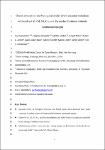Physical and biogeochemical controls on seasonal iron, manganese, and cobalt distributions in Northeast Atlantic shelf seas
| dc.contributor.author | Chen, X-G | |
| dc.contributor.author | Rusiecka, D | |
| dc.contributor.author | Gledhill, M | |
| dc.contributor.author | Milne, Angela | |
| dc.contributor.author | Annett, AL | |
| dc.contributor.author | Beck, AJ | |
| dc.contributor.author | Birchill, AJ | |
| dc.contributor.author | Lohan, MC | |
| dc.contributor.author | Ussher, Simon | |
| dc.contributor.author | Achterberg, EP | |
| dc.date.accessioned | 2023-03-28T12:41:28Z | |
| dc.date.available | 2023-03-28T12:41:28Z | |
| dc.date.issued | 2023-05 | |
| dc.identifier.issn | 1872-9533 | |
| dc.identifier.issn | 1872-9533 | |
| dc.identifier.uri | https://pearl.plymouth.ac.uk/handle/10026.1/20640 | |
| dc.description.abstract |
Dissolved (<0.2 μm) trace metals (dTMs) including iron (Fe), manganese (Mn), and cobalt (Co) are micronutrients that (co-) limit phytoplankton growth in many ocean regions. Here, we present the spatial and seasonal distributions of dFe, dMn, and dCo on the Northeast Atlantic continental margin (Celtic Sea), along a transect across the shelf and two off-shelf transects along a canyon and a spur. Waters on the continental shelf showed much higher dTM concentrations (dFe 0.07–6.50 nmol L−1, average 1.41 ± 0.96 nmol L−1, n = 138; dMn 0.868–14.8 nmol L−1, 2.75 ± 2.37 nmol L−1, n = 148; dCo 54.8–217 pmol L−1, 109 ± 32 pmol L−1, n = 144) than on the slope (dFe 0.03–1.90 nmol L−1, 0.65 ± 0.43 nmol L−1, n = 454; dMn 0.223–1.14 nmol L−1, 0.58 ± 0.20 nmol L−1, n = 458; dCo 27.3–122 pmol L−1, 71.7 ± 11.7 pmol L−1, n = 441), attributed to strong dTM contributions from a low-salinity endmember, i.e., riverine discharge. Benthic sedimentary input via reductive dissolution (especially for dFe and dMn), delineated by short-lived radium (Ra) isotopic activities (223Raxs and 224Raxs), was only prominent at a station (Site A) characterized by fine sediments. On the continental slope, dMn levels at depth were mainly determined by the formation of insoluble Mn oxides and the intrusion of Mediterranean Outflow Waters. In contrast, dFe and dCo concentrations at depth were balanced by the regeneration from remineralization of sinking organic particles and scavenging removal. In addition, bottom and intermediate nepheloid layers along the slope illustrated both elevated dTM concentrations and Ra isotopic activities. The presence of nepheloid layers is especially significant along the canyon transect relative to the spur transect, demonstrating the importance of slope topography on the off-shelf transport of dTMs into the Northeast Atlantic Ocean. As a seasonal stratified shelf sea, dTMs and nutrients showed synchronized seasonal variations on the shelf, indicating the influence of biological processes in addition to source effects. Surface dFe and dCo were depleted in summer due to enhanced biological uptake, while sub-surface dFe and dCo were elevated in summer and autumn ascribed to the remineralization of sinking organic particles. In contrast, surface dMn levels were predominantly controlled by the seasonal variations in photoreduction, while sub-surface dMn concentrations were relatively constant throughout the year. The combined effects of fluvial and benthic sources, topographical controls, and biological processes shape the seasonal variations of dTM distributions. Such seasonal variations in dTMs and biological activities can affect the biological carbon pump on the Northeast Atlantic continental margin, and may further influence the carbon cycle in the Atlantic Ocean via the dynamic dTM exchange between continental margins and the open ocean. | |
| dc.format.extent | 278-295 | |
| dc.language | en | |
| dc.publisher | Elsevier | |
| dc.subject | Dissolved trace metals | |
| dc.subject | North Atlantic | |
| dc.subject | Remineralization | |
| dc.subject | Seasonal variation | |
| dc.subject | Radium isotopes | |
| dc.title | Physical and biogeochemical controls on seasonal iron, manganese, and cobalt distributions in Northeast Atlantic shelf seas | |
| dc.type | journal-article | |
| dc.type | Journal Article | |
| plymouth.author-url | https://www.webofscience.com/api/gateway?GWVersion=2&SrcApp=PARTNER_APP&SrcAuth=LinksAMR&KeyUT=WOS:000966133800001&DestLinkType=FullRecord&DestApp=ALL_WOS&UsrCustomerID=11bb513d99f797142bcfeffcc58ea008 | |
| plymouth.volume | 348 | |
| plymouth.publication-status | Published | |
| plymouth.journal | Geochimica et Cosmochimica Acta | |
| dc.identifier.doi | 10.1016/j.gca.2023.03.023 | |
| plymouth.organisational-group | |Plymouth | |
| plymouth.organisational-group | |Plymouth|Research Groups | |
| plymouth.organisational-group | |Plymouth|Faculty of Science and Engineering | |
| plymouth.organisational-group | |Plymouth|Faculty of Science and Engineering|School of Geography, Earth and Environmental Sciences | |
| plymouth.organisational-group | |Plymouth|Research Groups|Marine Institute | |
| plymouth.organisational-group | |Plymouth|REF 2021 Researchers by UoA | |
| plymouth.organisational-group | |Plymouth|Users by role | |
| plymouth.organisational-group | |Plymouth|Users by role|Academics | |
| plymouth.organisational-group | |Plymouth|Research Groups|BEACh | |
| plymouth.organisational-group | |Plymouth|REF 2021 Researchers by UoA|UoA07 Earth Systems and Environmental Sciences | |
| plymouth.organisational-group | |Plymouth|Users by role|Researchers in ResearchFish submission | |
| dcterms.dateAccepted | 2023-03-16 | |
| dc.date.updated | 2023-03-28T12:41:25Z | |
| dc.rights.embargodate | 2024-3-24 | |
| dc.identifier.eissn | 1872-9533 | |
| dc.rights.embargoperiod | forever | |
| rioxxterms.versionofrecord | 10.1016/j.gca.2023.03.023 |


